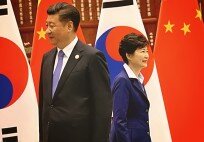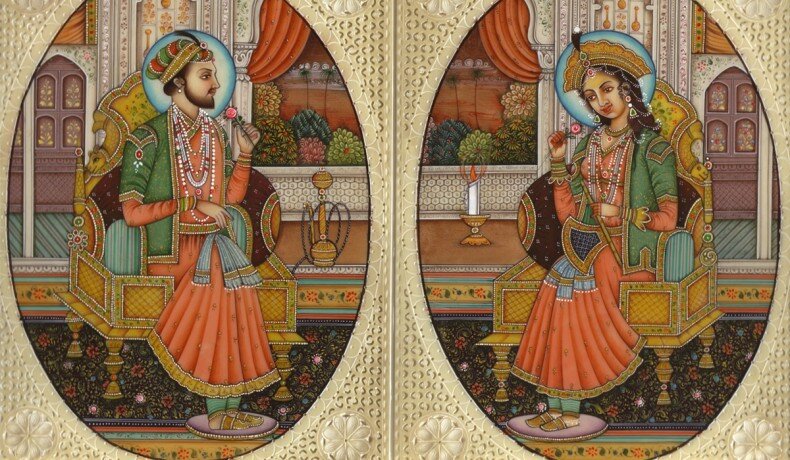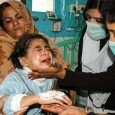By Ayesha Majeed –
Besides their impassioned interest in painting, architecture, jewellery-making and poetry, Mughals also gave special attention to the costume, textiles, patterning, cuts and delicate hand work on their garments
This is an attempt to frame the rich history of costumes and textiles that this subcontinent enjoyed in the reign of Mughal emperors (1526-1857). Their leisurely and relaxed life style provided the artisans with the atmosphere of creativity and experimentation with contemporary ideas and philosophies. Besides their impassioned interest in painting, architecture, jewellery-making and poetry, Mughals also gave special attention to the costume, textiles, patterning, cuts and delicate hand work on their garments.
 It’s interesting to study (from miniature paintings and chronicles) that the trends and the styles they developed were modern, stylish and very contemporary and till now are being replicated by fashion designers and even film directors around the world. The art of dying, crinkling, patterning, indigo, tie and dye, starching and embroidery that Mughals introduced is remarkable and the artisans of the subcontinent are practicing to retain this unique specialty in their Karkhanas (workshops) till now.
It’s interesting to study (from miniature paintings and chronicles) that the trends and the styles they developed were modern, stylish and very contemporary and till now are being replicated by fashion designers and even film directors around the world. The art of dying, crinkling, patterning, indigo, tie and dye, starching and embroidery that Mughals introduced is remarkable and the artisans of the subcontinent are practicing to retain this unique specialty in their Karkhanas (workshops) till now.
In the reign of Babar (1526-1530) mostly CHAFAN (long coat) and POSTIN (sheep skin coats) were used. Although these garments were not suitable for sweltering heat of this subcontinent, but writings of the time suggest that he must have worn them for traditional reasons as he wanted to retain the costumes of his home land; Turkestan .
In the reign of Akbar along with architecture, painting, textiles the style of garments also flourished a lot. He employed Persian Ustaads to instruct craftsman and weavers of the subcontinent to learn new techniques and the specialized textiles were woven, sometimes exclusively for royal usage. There is a marked fusion of Persian Muslim and Hindu clothing style in his period.
 Akbar also created a whole new vocabulary for clothing and textiles by romanticizing the names of garments such as “SHAWL” was renamed as “PARAMNARAM” means ‘extremely soft’, “BURQA & HIJAB” were named as “CHITRAGUPATA” means ‘which hides the face’ and “JAMA” was called as “SARBGATI” means ‘which covers the entire body’. The chronicles from this period suggest that this fusion of Persian, Arabic and Indian was confined to the court only and did not filter down to the masses.
Akbar also created a whole new vocabulary for clothing and textiles by romanticizing the names of garments such as “SHAWL” was renamed as “PARAMNARAM” means ‘extremely soft’, “BURQA & HIJAB” were named as “CHITRAGUPATA” means ‘which hides the face’ and “JAMA” was called as “SARBGATI” means ‘which covers the entire body’. The chronicles from this period suggest that this fusion of Persian, Arabic and Indian was confined to the court only and did not filter down to the masses.
From the paintings and Akbar Nama we find detailed record of costumes, along with written details of the garments style and how they were worn in Akbar’s reign. He was famous to have taken personal interest in the fashioning of court costumes. The most important costumes of his time is CHAK-DAAR-JAMA. Although this garment was in use in subcontinent at the time of Kushans or Scythians when foreign invaders were shown in Jama-like-coats in Gandhara sculptures and on the coins of that period. After Kushans this garment went out of use or fashion in this area. It reappeared again in sixteenth century and Akbar actually restyled Jama by removing the slits, rounding the hemline and increasing the fullness of the skirt. The interesting fact of the new version was that earlier Hindu Chaak-Daar-Jama was fastened on the left side but Akbar ordered that Muslim should fasten Jama on the right side to maintain the distinction between the two communities and respect for their different religious beliefs and practices. Jama was therefore a powerful symbol of religious and social identity. It was during Akbar’s reign (1556-1605) that Jama became the official court costume.
 Instead of buttons and loops Jama was fastened with two pairs of ties. It had tight fitted sleeves till waist and was commonly so long as to form soft folds along the forearm. The quality of fabrics, its gathers and the length of the sleeves of a wearer also used to indicate his wealth and social status. The influence of Persian flora and fauna and the “Booti” design that is mostly evident in the miniature paintings and also on the fresco designing of Mughal architecture can be identified in Mughal Jamas and other textile patterns. Crinkling, Sinjaf and enormous amount of “Kalis” were added to enhance the beauty of the garment. Extra attention was given to the embellishments mostly on the hemline and Sinjaf. Intricate “Moti Work”, “Badla” and “Gold Gotta” were used for the purpose.
Instead of buttons and loops Jama was fastened with two pairs of ties. It had tight fitted sleeves till waist and was commonly so long as to form soft folds along the forearm. The quality of fabrics, its gathers and the length of the sleeves of a wearer also used to indicate his wealth and social status. The influence of Persian flora and fauna and the “Booti” design that is mostly evident in the miniature paintings and also on the fresco designing of Mughal architecture can be identified in Mughal Jamas and other textile patterns. Crinkling, Sinjaf and enormous amount of “Kalis” were added to enhance the beauty of the garment. Extra attention was given to the embellishments mostly on the hemline and Sinjaf. Intricate “Moti Work”, “Badla” and “Gold Gotta” were used for the purpose.
Patka was another main garment of Mughal, wardrobe (which can be identified in the Mughal paintings). Patka is derived from the Sanskrit word meaning Patta the closest meaning of this word is “strip”. It draped elegantly from the shoulders of mostly courtiers, emperors and noblemen, from which a jeweled sword could be suspended. They were adorned with different dye techniques, block-printing, embroidery and even intricate woven techniques. Some paintings also show Patkas decorated with fringes. The embellishment of this garment was also dependent on the social status and wealth of the wearer.
Turban or Pagri was another most important accessory of male garments in Mughal period. It was a symbol of identity as it proclaimed caste, social status and religion. Even the region from where the wearer belonged were identified from the type and wrapping style of the turban. Mostly emperors wore turbans studded with precious jewels, diamonds. Some times their cloth is as long as twenty-five meters and twenty centimeters wide. They were usually tie-dyed and worn with the ends left hanging at the back. Single colored turbans were used for daily purposes while for special ceremonies different techniques and patterns of tie and die like “Lahria’ (wavy), Mothra (checked), and Chunari (dotted) were used. For emperors and nobles special urban dressers (pagri bands) were employed to tie “special pagri”.
ANGRAKHA like jama was another main garment worn by Mughals. It can be broadly defined as long sleeved gown or coat. Its most distinguished characteristic is the round-edged sometimes triangular opening at the front and the inner panel called Purdah (curtain). Some Angrakhas were made up of bodice attached to the skirt. This garment was also dependent on the wealth of the wearer for the choice of fine cloth, intricate embroidery work and precious materials for embellishments
Besides being a fashionable garment Angrakha was also used as a cavalry costume. The Pardah in this case was made up of padded material and acted like a shield for the soldiers. The word Angrakha is derived from the Sanskrit word “ANGARAKSHAK” meaning “protector of limbs”. This meaning also justifies the theory of Angrakha’s use as a cavalry costume. Fortunately the appropriate cuts (mainly for easy mobility) allowed the garment to retain its life as Angrakha’s are still in use even in its traditional form in many haute couture fashion wardrobes of subcontinent .
The patterns, cuts and different techniques of fine cloth making that Mughals introduced and enjoyed gave rise to a contemporary costume designing movement which influenced not only the south Asia but even the western costume designers took influence from their magnificent art of costume designing.
The writer is a freelance journalist and art critic based in Lahore. She can be reached at [email protected]































































































